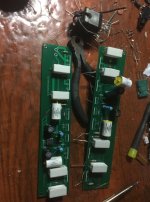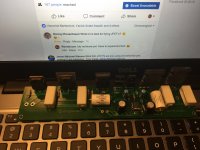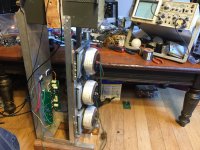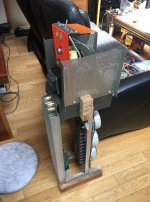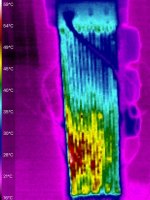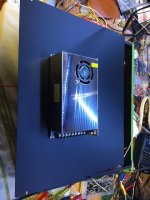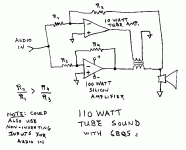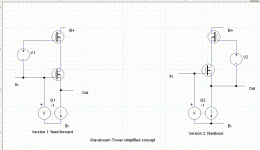My OTL amp. 
Attachments
But if it works.....I'm interested in more details of what you used!
Here is a discussion about simplified version, that has a link to the previous thread.
Modified Wavebourn Tower II ?
That's cheating!
Well, a source follower sounds better or the same as a cathode follower, especially, when loaded on a CCS, even if it is modulated.
However, it does not glow (except in IR, attached) But driver tubes glow. 1x6N1P and 2x6P15P
Attachments
Can you flick up some details of the SMPS you used for the heaters please?
Do you mean for GK-71?
I used some industrial 24V SMPS retuned to 20V. I found it in my barn, bought about 10 years ago.
otl are just stupid, you must rely on heavy fb (otherwise bias unstability related kaboom overcurrent)
damn hot too.
good triodes are meant for high z load - transformers.
which powersupply tubes are not that linear or great.
OTL present challenges, that's why I want to build one.
6AS7Gs are low Z devices which opens up the challenge as a possibility.
The AtmaSphere M60 design uses 1 dB of NFB which you can do without if you feel so inclined.
Well said, tsetse! I love building OTL amps, precisely because they present interesting challenges, and also just because it can actually be done.
I find it so depressing looking at some of the discussions one finds in SET threads, in particular, where some of the participants are just constructing the same old circuit over and over and over again, and then squabbling about which brand of power switch sounds better than another, or whatever their own particular misguided obsession is.
There are so many much more interesting challenges out there, like OTLs.
Tubes are heated with an SMPS. That's a common mode choke to get rid of any noise. There are a couple caps under it too. Amps are very quiet.
No, I was curious what SMPS he has used here.....
Thanks,
Drew.
I gave up vacuum tubes in OTL amps. Here is a nice "tube" with 9A/V transconductance.
https://www.wolfspeed.com/downloads/dl/file/id/959/product/222/c3m0075120k.pdf
Wavebourne, That's some cutting edge stuff. Way above my pay grade. I use silicon carbide materials every day at my job but don't think I can make an amp with it

No, I was curious what SMPS he has used here.....
Thanks,
Drew.
Hi Drew, SMPS is a 12V 20A fleabay special. Output (6N13S) tubes are connected series-parallel so they draw around 12 amps. Small tubes are 12SN7GTA's which are much cheaper that the 6SN7. The SMPS has very slow start up which is easy on the heaters. I've since cut ventilation holes in the bottom covers. Also cut a hole for the ps fan and flipped it over to prevent it from just circulating hot air around inside the chassis. Ralph (Atma-Sphere) deserves all the credit for the circuit. It's amazing. Class A and no feedback.
Attachments
That's cheating!
If you can use a SMPS for power, why not use a SS amplifier for power.
Take any SS amplifier, and run the a speaker line through a big current xfmr toroid (a few turns, or use a typical HV to LV power toroid ). Then your tube amplifier puts the final finish on the voltage waveform. (a Tube Veneer Amp)
It's actually equivalent to a class G or class H amplifier, with the big amplifier supplying the variable tracking B+ power for the small amplifier. The small amplifier operates with just small voltage changes across the tube (from the supplied tracking B+ from the big amp) to finish the waveform.
The OT for the tube amp is very low Zout, so the small tube amp can supply the same big current as the big amplifier. Just making small voltage variation, to set the final distortion profile.
The tube amp can run class A for final purity, while the "supply" amp can run class aB for efficiency. Or even class D. You want beam pentodes in the tube amp so that the final output is isolated from the "variable B+ tracking supply". Same as any class H amplifier. (tracking supply to the output device collector or drain typically)
The small tube amp actually uses a fixed internal B+ for the OT center tap. The tracking part of the class G or H is simply being kept to the LV side of the OT (but effectively in series with the internal fixed B+). So this is all
--very simple-- and cheap to build. With extreme fidelity results. This simple and cheap design can add tube sound easily to --ANY-- SS amplifier out there, or already in your living room.
Attachments
Last edited:
Why make it so complicated?If you can use a SMPS for power, why not use a SS amplifier for power.
Take any SS amplifier, and run the a speaker line through a big current xfmr toroid (a few turns, or use a typical HV to LV power toroid ). Then your tube amplifier puts the final finish on the voltage waveform. (a Tube Veneer Amp)
It's actually equivalent to a class G or class H amplifier, with the big amplifier supplying the variable tracking B+ power for the small amplifier. The small amplifier operates with just small voltage changes across the tube (from the supplied tracking B+ from the big amp) to finish the waveform.
The OT for the tube amp is very low Zout, so the small tube amp can supply the same big current as the big amplifier. Just making small voltage variation, to set the final distortion profile.
The tube amp can run class A for final purity, while the "supply" amp can run class aB for efficiency. Or even class D. You want beam pentodes in the tube amp so that the final output is isolated from the "variable B+ tracking supply". Same as any class H amplifier. (tracking supply to the output device collector or drain typically)
The small tube amp actually uses a fixed internal B+ for the OT center tap. The tracking part of the class G or H is simply being kept to the LV side of the OT (but effectively in series with the internal fixed B+). So this is all
--very simple-- and cheap to build. With extreme fidelity results. This simple and cheap design can add tube sound easily to --ANY-- SS amplifier out there, or already in your living room.
The circlotron , as Ralph (Atmasphere) has publiced here, works just fine...?
My experience with hybrid amplifiers (tube input , driver MOSFet/bipolar current amplifier) is that it is good , but somehow looses the magic of the tubes.
Nothing complicated at all. (just the explanation)
Nothing Hybrid about it either, except the "tracking power supply". It IS Tube output.
Cheap to make with a low cost power toroid OT.
Does not produce a heat wave, even in class A, and maintains a low damping factor.
Just a low power P-P tube amp using a small power toroid OT or current xfmr.
Only thing different is the secondary winding impedance is more like 0.1 Ohm.
Nothing Hybrid about it either, except the "tracking power supply". It IS Tube output.
Cheap to make with a low cost power toroid OT.
Does not produce a heat wave, even in class A, and maintains a low damping factor.
Just a low power P-P tube amp using a small power toroid OT or current xfmr.
Only thing different is the secondary winding impedance is more like 0.1 Ohm.
Last edited:
Wavebourne and smoking-amp,
I recognise you guys are not for an OTL tube amp, however can you please refrain from pushing SS designs down our throats and quietly berating us for wanting to build tube OTL amps.
I appreciate your skills and experience, however I have no need to continuously have this thrown at us, this is a tube thread, how would it go if I came to your design threads and just pushed tubes because that is what I like. It feels to me that you think we are nuts for pursuing these, however please respect this is our choice to build for our living/listening rooms. You do not have to live with this choice.
I do however think you can assist with layout and powersupply design as you guys obviously have skills here.
As the saying goes, "horses for courses".
Please respect our choices.
Thanks.
I recognise you guys are not for an OTL tube amp, however can you please refrain from pushing SS designs down our throats and quietly berating us for wanting to build tube OTL amps.
I appreciate your skills and experience, however I have no need to continuously have this thrown at us, this is a tube thread, how would it go if I came to your design threads and just pushed tubes because that is what I like. It feels to me that you think we are nuts for pursuing these, however please respect this is our choice to build for our living/listening rooms. You do not have to live with this choice.
I do however think you can assist with layout and powersupply design as you guys obviously have skills here.
As the saying goes, "horses for courses".
Please respect our choices.
Thanks.
- Home
- Amplifiers
- Tubes / Valves
- What tubes for a OTL tube amp?
